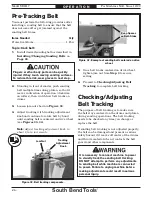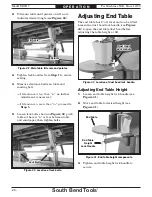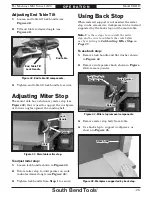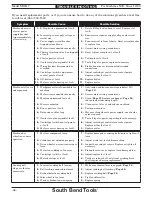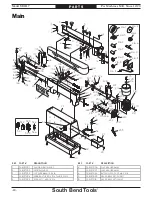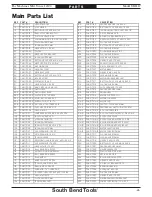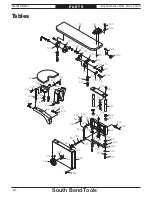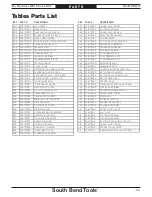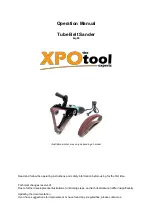
South Bend Tools
For Machines Mfd. Since 12/20
Model SB1117
-37-
TROUBLESHOOTING
Symptom
Possible Cause
Possible Solution
Deep sanding
grooves or scores in
workpiece.
1.
Using too coarse of sanding grit.
1.
Use finer grit sanding belt (Page 24).
2.
Workpiece sanded across grain.
2.
Sand with workpiece grain.
3.
Too much pressure against belt.
3.
Reduce pressure on workpiece while sanding.
4.
Workpiece held still for too long.
4.
Do not keep workpiece in one place for too long.
5.
Graphite pad on platen damaged.
5.
Replace graphite pad.
Abrasive grit rubs
off the belt easily.
1.
Sanding belt has been stored in an
incorrect environment.
1.
Replace sanding belt (Page 24). Store sanding belt
in a cool, dry area.
2.
Sanding belt has been folded or
crushed.
2.
Replace sanding belt (Page 24). Store sanding belt
flat, not folded or bent.
Sanding belt
surfaces clog
quickly or burn.
1.
Worn sanding belt.
1.
Replace sanding belt (Page 24).
2.
Too much pressure against belt.
2.
Reduce pressure on workpiece while sanding.
3.
Sanding softwood.
3.
Use different stock or accept characteristics of
workpiece and plan on cleaning/replacing belt
frequently.
4.
Workpiece has high moisture
content or sap.
4.
Use different stock or accept characteristics of
workpiece and plan on cleaning (Page 32)/replacing
belt frequently (Page 24).
5.
Using too fine of sanding grit.
5.
Use coarser grit sanding belt (Page 24).
6.
Poor dust collection.
6.
Unclog ducts; close gates to improve suction; re-
design dust collection system.
Burn marks on
workpiece.
1.
Using too fine of sanding grit.
1.
Use coarser grit sanding belt (Page 24).
2.
Too much pressure against belt.
2.
Reduce pressure on workpiece while sanding.
3.
Workpiece held still for too long.
3.
Do not keep workpiece in one place for too long.
4.
Sanding belt loaded with sawdust,
resin, and/or pitch.
4.
Clean (Page 32) or replace belt (Page 24).
Glazed sanding
surfaces.
1.
Sanding wet stock.
1.
Dry stock properly before sanding (Page 23).
2.
Sanding stock with high pitch/
residue.
2.
Use different stock or accept characteristics of
workpiece and plan on cleaning (Page 32)/replacing
belt frequently (Page 24).
3.
Belt worn or filled with pitch/
residue.
3.
Replace belt or clean pitch/residue from belt
(Page 32).
Workpiece
frequently gets
pulled out of your
hand.
1.
Not supporting workpiece properly.
1.
Use backstop/miter stop to support workpiece.
2.
Starting workpiece on a leading
corner.
2.
Start workpiece on a trailing corner.
Belt does not track
correctly.
1.
Belt tracking needs adjustment.
1.
Adjust sanding belt tracking (Page 26).
2.
Incorrect sanding belt tension.
2.
Make sure tension lever is engaged. (Page 24).
3.
Sanding belt damaged, worn, or
misshapen.
3.
Replace sanding belt (Page 24).
Sanded surface not
square when main
table tilt and miter
stop both set to 0
°
.
1.
Main table not perpendicular to
platen/belt.
1.
Calibrate tilt scale (Page 34).
2.
Miter stop not perpendicular to
platen/belt.
2.
Calibrate miter stop scale (Page 35).
Snake-shaped
marks on
workpiece.
1.
Sanding belt loaded with sawdust,
resin, and/or pitch.
1.
Clean (Page 32) or replace belt (Page 24).
2.
Sanding belt damaged.
2.
Replace sanding belt (Page 24).
Содержание SB1117
Страница 48: ...southbendtools com Printed In Taiwan CS21567...




